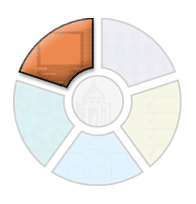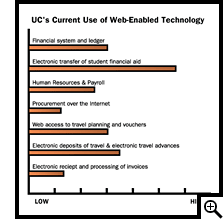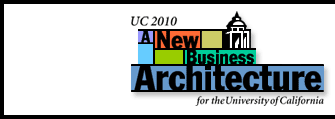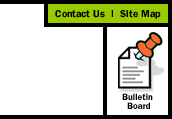






|
 |
 |
 |
 |
 Advances in technology and communications over the past ten years have allowed the University to implement many components of the network organization structure described in the 1991 Sustaining Excellence report. The University now benefits from an environment that is connected and managed using integrated technology and information. Technology has been used effectively as an enabling tool allowing off-line processes and procedures to be transferred online. High-level analysis of the current technology environment reveals that campuses have made significant investments to "Web enable" the University, as illustrated in the graph to the right. Advances in technology and communications over the past ten years have allowed the University to implement many components of the network organization structure described in the 1991 Sustaining Excellence report. The University now benefits from an environment that is connected and managed using integrated technology and information. Technology has been used effectively as an enabling tool allowing off-line processes and procedures to be transferred online. High-level analysis of the current technology environment reveals that campuses have made significant investments to "Web enable" the University, as illustrated in the graph to the right.
Consistent with the business world, most campuses first developed Web interfaces in "customer facing" applications such as student services. Students now routinely access grades, schedules and other student information via the Internet. As student Web access becomes commonplace, older types of self-service technology, like voice registration systems, are being phased out or eliminated.
A similar evolution is occurring in the realm of business and administrative services. As the chart on the previous page indicates, the UC is relying increasingly on Web-enabled business applications. Most campuses have implemented electronic transfer to deposit student financial aid funds, reducing physical check printing by as much as 70 percent in some cases.
The University has also made significant advances in providing campuses and departments with electronic access to business information and technology tools. Administrative departments across most UC campuses have Web access to general ledger and payroll/human resources data. Most campuses provide capabilities to order goods and supplies using the Internet, with UCLA planning to offer full e-procurement capabilities by year-end 2000. Many of the campuses provide Web access to their travel planning and voucher systems.
Most campuses have the capability to receive and process invoices electronically. Currently, approximately one-fourth of all invoices are processed electronically, but that number is growing rapidly as standards emerge that allow for easy exchange of information between the University and vendors.
Ubiquitous Technology Tools
While the University has historically focused on using technology as an enabling tool, the future requires us to see it as a tool to transform and revolutionize our administrative and support infrastructure. Moving forward, more innovative uses of technology will allow for significant productivity improvements that will help accommodate anticipated employee- and student-growth rates.
To accomplish these objectives UC must define an e-commerce strategy that encompasses all areas of the University's computing environment. Common standards and protocols are needed to allow us to fully leverage and harness the potential of emerging technology. Where we have focused on building and expanding our network organization in the past, we now need to shift our focus to the individuals who perform business and administrative functions throughout the University. The emphasis will be on providing each employee (a "market of one") with easy, intuitive access to anything they need to do their job, anytime, and from multiple access points, including wireless data ports.
Transition to the Web
Today, the University systems and technological resources are accessed by users via their desktop or laptop computers connected via hard-wired access to LANs and the Internet. In the future, access to these systems and underlying data will be far more ubiquitous. As bandwidth capabilities expand and wireless access becomes more common, the University will need to enhance current systems to harness the benefits associated with such improvements. The resulting increase in virtual transactions will result in fewer on-campus, in-person transactions. This will require a corresponding change in processes and procedures that accommodate a virtual environment. The University will need to provide customer service in the online environment, with greater opportunities for customers to access systems and solve their problems on their own time. In order to develop and provide ongoing support for the content and technology infrastructure required for the New Business Architecture, the University will need to be organized to take full advantage of its resources.
Electronic Commerce
Over the next few years financial and procurement transactions will offer opportunities for cost savings and service improvements. In the near term, common standards will replace the current lack of accepted standards for authentication and payment, raising the level of consumer confidence and promoting greater use of the Web for financial transactions. Such standards will allow for virtually unlimited opportunities for trading- partner arrangements, ranging from online auctions to automated procurement, and more.
Making the necessary investments in e-procurement systems will allow UC staff to manage all aspects of the purchasing process online from their desktop. Purchases will be made over the Internet using electronic catalogs that allow users to search for products and services by price, category, description, supplier reference number or other criteria. Frequently purchased items are automatically maintained on the employee's "quick list" for faster replenishment. Manual transaction processing is minimized as the system generates electronic purchase orders that are automatically matched with electronic invoices received from the supplier. Payment is transmitted electronically in accordance with optimal payment terms once an electronic goods receipt or service verification is received.
The University will benefit from a self-service environment where staff are able to acquire materials and services faster and easier than is possible in today's environment. In addition to saving money, leveraging UC's purchasing dollars will allow the University to put high level skills where it will have the most impact. The reduction in manual and paper transaction processing will allow procurement staff to spend more time negotiating contracts, managing vendor relationships and identifying strategic purchasing opportunities. The potential cost savings are enormous. As an example, the University of Pennsylvania estimates that its current paper-based requisition system costs about $150 per purchase. In contrast, they expect their electronic procurement system to reduce the same costs to about $10 to $15 per transaction.
Secure Technology Environment
Along with investments in new business systems, the University must continue to invest in enhanced security. A secure environment is essential for the sharing of financial and other information within the University and with external business partners. Operating in a Web-based environment requires a secure environment capable of:
- Protecting the confidentiality of sensitive data
- Supporting a robust and reliable means of remote access to digital resources
- Supporting e-commerce
- Guaranteeing the authenticity of digital records
- Ensuring that accountability for electronic transactions is authentic and documented
Public Key Infrastructure (PKI) technology was developed to address a wide range of administrative and business processes that require proof of the identity of participants in a transaction; proof that the contents of communications have not been tampered with; and protection of sensitive or restricted data. PKI is based on the use of "digital certificates" that verify the identity of individuals and the integrity of documents, and ultimately enable "signatures" on digital documents.
A Universitywide PKI initiative will allow the University of California to speak with one voice when developing agreements for use of its digital credentials to interact with outside agencies and organizations. It will also avoid the problems of multiple implementations of PKI, where one organization does not recognize the digital credentials issued by another.
Technology Strategies:
- Develop an electronic commerce solution for the University
- Implement a common UC solution for electronic procurement
- Allocate resources and implement the UC Employee Systems Initiative (ESI) — See Appendix E
- Identify self-service application opportunities for both employees and customers
- Adopt industry technology architectures and standards for Web-based applications, electronic data interchange and wireless and mobile technology
- Eliminate paper-based processes and forms within two years; make data digital from the start to facilitate E-commerce solutions
- Ensure adequate authentication and security by implementing PKI and other digital security tools
|
 |
| |
|
 |
|




